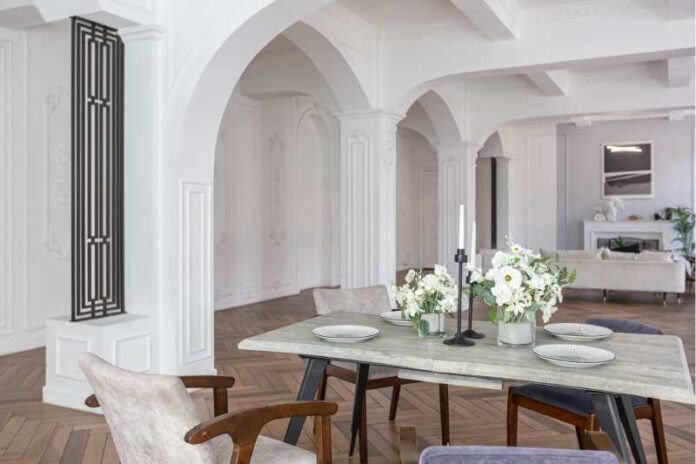
When you envision Spanish architecture, what images spring to mind? Uniquely designed geometric tiles and sun-drenched courtyards. But all that’s too cursory. You can only understand Spanish architecture fully if you dive into its intricate details, features, historical influences, and regional diversity.
Being someone eager to delve deeper, you would be glad that this article will take you on a journey to the depths of Spanish architecture and interior design.
The Timeless Influence of Moorish Heritage
The Moorish influence has profoundly impacted Spanish architecture and interior design, particularly in regions like Andalusia. This influence, a cherished aspect of Spain’s rich heritage, was shaped by centuries of Moorish rule, leaving a lasting impression on the country’s architectural legacy.
Intricate patterns and geometric motifs are at the heart of this influence, most notably showcased in the iconic horseshoe arches that adorn many Spanish buildings. These arches not only exude elegance but also serve practical purposes, enhancing the overall beauty and structural integrity of these edifices.
The extensive use of azulejos is another hallmark of Spanish design. Azulejos are a testament to artistry that feature geometric patterns and have been used to adorn both interior and exterior surfaces. The Alhambra in Granada stands out as one of the most emblematic illustrations of this influence.
Regional Diversity
Spain’s diverse architecture is a testament to its rich geography. Catalan Modernism, also known as Art Nouveau, takes center stage in Catalonia, guided by the visionary architect Antoni Gaudí. His creations, like the Sagrada Família, seamlessly blend nature and architecture, evident in the curvaceous lines and vibrant mosaics that evoke the natural world.
Moving to central Spain, particularly Toledo, the Mudéjar style thrives, a proof of Spain’s cultural tapestry, harmoniously weaving Islamic design elements into Christian structures, showcasing ornate wooden coffered ceilings and intricate geometric patterns.
Meanwhile, in the Basque Country, local materials like stone and wood shape architecture, with half-timbered houses and steep gabled roofs, reinforce a deep connection to the environment and a distinct cultural identity. Spain’s architecture is a living narrative, each region telling its unique story through its buildings—a fusion of history, nature, and local pride.
The Authenticity of Materials
It is all about the materials used in Spanish interior design, which makes it stand out. Spanish architecture values using locally sourced materials, making buildings feel connected to their surroundings.
If you evaluate the tiles and flooring, terra cotta is one of the most popular ones. People usually buy terracotta tiles because of their warm, reddish-brown hue, which adds a signature look to their home’s interior during hot Spanish summers.
One another essential element here is wrought iron, which is used for decorative touches like railings and light fixtures. It imparts a sense of refinement and artistry to indoor spaces, serving as a link between architectural design and decorative elements.
Apart from that, locally sourced stone and wood are also significant, especially in rural and coastal areas, offering durability and a timeless look that harmonizes with nature.
A Look Into the Courtyards
Courtyards, known as “patios,” in Spanish, are a cherished feature of Spanish architecture. They are more than just architectural features; they are living extensions of homes that foster community gatherings, showcasing the interconnectedness of nature and architecture.
These private outdoor spaces within homes bring a touch of nature inside. With carefully chosen plants, soothing fountains, and intricate tilework, courtyards capture the essence of Spanish living. They provide a peaceful escape from the outside world while bringing natural light and ventilation into interior spaces.
Interior Design: Comfort and Elegance
Spanish interior design focuses on comfort and elegance, blending aesthetics and functionality seamlessly. Terracotta flooring serves as a foundation, offering both visual appeal and temperature control, particularly in the Mediterranean climate. Wrought iron accents, from outdoor railings to indoor fixtures, bring sophistication and craftsmanship to interiors. The color palette often features earthy tones like brown, blue, and red, creating a warm and inviting atmosphere.
Exposed wooden beams on ceilings connect spaces to the architectural heritage. Arched doorways and windows create flow and unity between rooms. Textiles, including embroidered fabrics and area rugs, add texture and patterns, enhancing the cozy and welcoming ambiance. Handcrafted wooden furniture, often featuring intricate details, adds character and history to interiors.
Contemporary Trends
If you have a look at the modern Spanish interior design, it finds harmony by blending traditional elements with contemporary trends. The synergy between an uncluttered design, a minimalist sensibility, and a palette of neutral hues beautifully enhances the historical elements.
Contemporary spaces often prioritize simplicity and allow architectural elements and materials to shine. Minimalist furniture and modern fixtures create openness while preserving historical charm. This blend of old and new highlights the adaptability of Spanish design, evolving while honoring its rich heritage.
Conclusion
To conclude, Spanish architecture and interior design are a rich blend of history, regional diversity, and a strong connection to nature. From Moorish influences to unique regional styles, Spain’s buildings have unique stories to tell.
The use of locally sourced materials, serene courtyards, and a focus on comfort and elegance are hallmarks of its design. Even in contemporary trends, Spain combines tradition and modernity, showcasing its timeless allure and adaptability.





